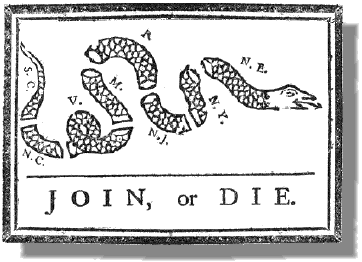The Gadsden Flag

The rattlesnake was the favorite animal emblem of the Americans even before the Revolution.
In 1751 Benjamin Franklin's Pennsylvania Gazette carried a bitter article protesting the
British practice of sending convicts to America. The author suggested tht the colonists return
the favor by shipping "a cargo of rattlesnakes, which could be distributed in St. James Park,
Spring Garden, and other places of pleasure, and particularly in the noblemen's gardens."
Three years later the same paper printed the picture (as seen above) of a snake as a commentary on the
Albany Congress. To remind the delegates of the danger of disunity, the serpent was shown cut to
pieces. Each segment is marked with the name of a colony, and the motto "Join or Die" below.
Other newspapers took up the snake theme.
By 1774 the segments of the snake had grown together, and the motto had been changed to read:
"United Now Alive and Free Firm on this Basis Liberty Shall Stand and Thus Supported Ever Bless
Our Land Till Time Becomes Eternity"
Other authors felt the rattlesnake was a good example of America's virtues. They argued that
it is unique to America; individually its rattles produce no sound, but united they can be
heard by all; and while it does not attack unless provoked, it is deadly to step upon one.

The Gadsden Flag


The Gadsden Flag: The American Revolutionary period was a time of intense but controlled individualism - when
self-directing responsible individuals again and again decided for themselves what they should
do, and did it- without needing anyone else to give them an assignment or supervise them in
carrying it out.
Such a person was the patriot Colonel Christopher Gadsden of South Carolina. He had seen and
liked a bright yellow banner with a hissing, coiled rattlesnake rising up in the center, and
beneath the serpent the same words that appeared on the Striped Rattlesnake Flag - Don't Tread
On Me. Colonel Gadsden made a copy of this flag and submitted the design to the Provincial
Congress in South Carolina. Commodore Esek Hopkins, commander of the new Continental fleet,
carried a similar flag in February, 1776, when his ships put to sea for the first time.
Hopkins captured large stores of British cannon and military supplies in the Bahamas.
His cruise marked the salt-water baptism of the American Navy, and it saw the first landing of
the Corps of Marines, on whose drums the Gadsden symbol was painted.

The 1st Navy Jack


The 1st Navy Jack: One of the first flags flown by our Navy may have been an adaptation of
the "Rebellious Stripes" created at the time of the Stamp Act Congress. It featured thirteen
red and white stripes. Stretched across them was the rippling form of a rattlesnake, and
the words, "DON'T TREAD ON ME"- a striking indication of the colonists' courage and fierce
desire for independence.
The flag we know today as the first Navy Jack (sometimes known as the "Culpepper Flag")
is believed to have flown aboard the Alfred, flagship of the newly commissioned
Continental fleet, in January, 1776. American ships used this flag, or one of its variations,
throughout the Revolutionary War. This powerful American symbol was used by the Continental Navy in 1776
and is being used again by the U.S. Navy in the War on Terrorism.
|

